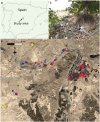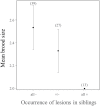Oral disease is linked to low nestling condition and brood size in a raptor species living in a highly modified environment
- PMID: 37091997
- PMCID: PMC10120997
- DOI: 10.1093/cz/zoac025
Oral disease is linked to low nestling condition and brood size in a raptor species living in a highly modified environment
Abstract
Anthropogenic stressors can favor the occurrence of noninfectious disease that can be worsened by the impact of opportunistic pathogens, making the epizootiology of environmental diseases difficult to unravel. The incidence and impact of oral lesions in nestlings of a facultative scavenger species, the black kite Milvus migrans, were examined over seven breeding seasons in the highly degraded environment close to Madrid, Spain. We found an overall prevalence of 31% of nestlings with oral lesions, with no clear spatial pattern in nests with affected and unaffected individuals. The occurrence and number of oral lesions were negatively associated with nestling body condition and brood size. Broods, where all siblings had oral lesions, were smaller than those where some or all siblings were apparently healthy, suggesting that oral disease could be causing nestling mortality and, consequently, brood size reduction. In turn, nestling body condition was negatively affected by lesion occurrence, brood size, and laying date. Although these relationships were bidirectional, piecewise structural equation modeling analyses showed a greater negative effect of body condition on lesion occurrence than vice versa, indicating that nestlings in poorer body condition were more likely to develop oral lesions (which could contribute to aggravate their state of deterioration) than those in better condition. Nestlings from small broods were also more likely to have oral disease (directly or indirectly through their lower body condition) than nestlings from large broods. Nestlings that hatched last in the broods showed greater development stress than those that hatched first. Anthropogenic stressors could trigger poor body condition, and contribute to microbiota dysbiosis-related diseases. Although further research is needed to determine the consequences for the long-term fitness of individuals, actions should be taken to mitigate adverse conditions that may favor the appearance of environmental diseases associated with peri-urban areas, given their rapid expansion over natural areas.
Keywords: body condition; breeding success; developmental stress; environmental disease; habitat degradation; opportunistic pathogens; pollution; raptor.
© The Author(s) 2022. Published by Oxford University Press on behalf of Editorial Office, Current Zoology.
Conflict of interest statement
The authors declare that all authors have no conflict of interest.
Figures





Similar articles
-
Fungal signatures of oral disease reflect environmental degradation in a facultative avian scavenger.Sci Total Environ. 2022 Sep 1;837:155397. doi: 10.1016/j.scitotenv.2022.155397. Epub 2022 Apr 20. Sci Total Environ. 2022. PMID: 35460785
-
Sex-specific effects of altered competition on nestling growth and survival: an experimental manipulation of brood size and sex ratio.J Anim Ecol. 2009 Mar;78(2):414-26. doi: 10.1111/j.1365-2656.2008.01505.x. Epub 2008 Dec 2. J Anim Ecol. 2009. PMID: 19054223
-
Differences in begging behaviour between barn swallow, Hirundo rustica, nestlings.Anim Behav. 1998 Apr;55(4):809-18. doi: 10.1006/anbe.1997.0675. Anim Behav. 1998. PMID: 9632469
-
Immune function and survival of great tit nestlings in relation to growth conditions.Oecologia. 1999 Nov;121(3):316-322. doi: 10.1007/s004420050934. Oecologia. 1999. PMID: 28308319
-
Polymorphism at the nestling stage and host-specific mimicry in an Australasian cuckoo-host arms race.J Anim Ecol. 2023 Jan;92(1):30-43. doi: 10.1111/1365-2656.13849. Epub 2022 Dec 11. J Anim Ecol. 2023. PMID: 36426636 Review.
Cited by
-
Immigration hides the decline caused by an anthropogenic trap and drives the spectacular increase of a mobile predator.Oecologia. 2024 Dec 23;207(1):15. doi: 10.1007/s00442-024-05656-2. Oecologia. 2024. PMID: 39714528
-
Antimicrobial Resistance and Virulence Potential of Bacterial Species from Captive Birds of Prey-Consequences of Falconry for Public Health.Animals (Basel). 2024 Mar 11;14(6):856. doi: 10.3390/ani14060856. Animals (Basel). 2024. PMID: 38539953 Free PMC article. Review.
References
-
- Banner KM, Higgs MD, 2017. Considerations for assessing model averaging of regression coefficients. Ecol Appl 27:78–93. - PubMed
-
- Baos R, Jovani R, Pastor N, Tella JL, Jiménez Bet al. , 2006. Evaluation of genotoxic effects of heavy metals and arsenic in wild nestling white storks Ciconia ciconia and black kites Milvus migrans from southwestern Spain after a mining accident. Environ Toxicol Chem 25:2794–2803. - PubMed
-
- Barton K, 2017. MuMIn: Multi-model inference. R package version 1. 40. 0. Available from: https://CRAN.R-project.org/package=MuMIn (accessed on 11 December 2021).
LinkOut - more resources
Full Text Sources
